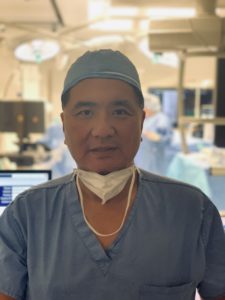
W. Michael Park, MD, was first turned onto the utility and wonder of anatomical sketching during medical school. Back then, he developed an affinity for the visual-learning benefits afforded by his own hand and for how much better it allowed him to absorb complexity over the alternative of staring endlessly at the drawings of others.
Since that time, Park has developed an intricate hand for surgical and anatomical sketching, lately sharing instructive examples via social media, alongside notes on the particular procedures they illustrate.
Many of his colleagues will engage in the practice of tracing out their procedures visually, at least on some rudimentary level, Park muses in an interview with Vascular Specialist. But his recent experience as chief of vascular surgery for the Cleveland Clinic Abu Dhabi underscored just how valuable his skill for graphical surgical sketches could be. “The pictures were very important because of the language barrier,” Park recalls. “People understand pictures. Especially for complex procedures, there’s no question the pictures helped bringing across complex concepts.
“Outside our small coterie of vascular surgeons, these are the dark arts. It’s mysterious: people may have been exposed to vascular surgery during a medical clerkship, medical school clerkship, or may have seen a video here and there, but the fact is 99% of doctors have very little idea of what vascular surgery is about. That’s one of the key points that have come up in society presidential talks is disseminating what we do and what we offer. I’m doing my little part.”
Patients, families and referring doctors in particular benefit greatly from sketches— typified by a recent example he shared of an in-situ bypass operation, Park explains: “Saying in-situ bypass to someone and them nodding their head… it’s very unlikely the patient understands exactly what is going to happen to them.” A sketch can preclude a patient waking up and wondering why they have incisions on their leg when they understood they were to undergo work to increase blood flow in their lower extremity.
The economy of a picture might bear even more dividends among referring doctors, continues Park, who recently returned to Cleveland, Ohio, from the Middle East. “If you can post this picture into your electronic medical record [EMR], it speaks volumes— much more than an op note. An op note can go on for pages, can be exquisitely detailed, lyrical even. It won’t capture a part of the information that’s conveyed in a picture.”

Park uses his imagery in many different ways. He deploys them for 3D reconstructions, planning for open surgery, and, with the increasing sophistication of technology, can have a completed sketch in a patient’s inbox within a few taps of a digital device. “It’s been a tremendous advantage to have that skill—I was lucky to come upon in medical school.”
Even simple sketches can be of asymmetrical benefit against voluminous wordage, he argues. “If you think about the economy of information that’s needed to convey an idea: It’s possible to describe something with very few graphical points. It’s sort of like being able to pass information digitally with very few bits; a symphony recording requires very few sample points; an idea for a bypass is really just connecting two dots.”
Park says he is coming across more and more of his colleagues who are artistically inclined. “The simple fact of the matter is that drawing something out is much more simple and less verbose than chattering on about something. You see people get lost in the details, in anatomical terms. The technical terms of surgery are challenging to teach in a short moment, but a picture will illustrate something very quickly.”
Tablet devices and phones now come armed with pens, making the ability to learn or refine the art of surgical sketches all the more accessible, Park notes. “It’s simple enough to learn and to have a docket of information to graphically show a procedure that you are going to do.”
Ultimately, the tool of communicating through pictures goes back to the earliest days of the human species, he ponders. “Cro magnon man was doing it 40,000 years ago, and he was doing it before written words. It’s a tool that is available to all of us, and requires very little practice— just lines, circles and dots. If you want to be fancy, use the air brush tool for shading, and all of a sudden the picture pops.”









